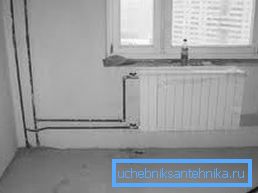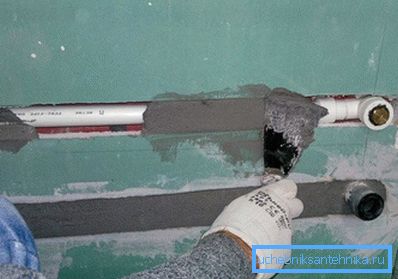How to close the pipes: 3 ways to disguise engineering
The pipes of the central heating system and the gas pipeline in the apartment play a very important role. But the metal or plastic part that stands out against the background of beautiful wallpaper is unlikely to organically complement your elegant interior. Let's figure out how to close the pipes in your home with your own hands, without resorting to the services of expensive designers and without hiring a hired team of builders to work.

The choice of material for work
Before proceeding to the design of the protective box or screen, you need to select the appropriate material. The advantages and disadvantages of certain solutions are listed in the table.
| Material | Description |
| Drywall | One of the most popular materials. It is distinguished by ease of installation and affordable price. After installation, drywall can be decorated with a film that simulates the texture of wood, wallpaper or choose a different design style, in harmony with the interior of the room. |
| MDF with lamination | A good decorative trim that imitates valuable and expensive wood. She can decorate any home. Laminated MDF does not collapse under the influence of moisture and temperature, because this material can be advised to those who do not know how to close the gas pipe in the kitchen. |
| Laminated chipboard | Its technical characteristics are similar to the previous material. Easy to cut and fasten. Plates of the right size can be ordered in the nearest furniture workshop. |
| Plywood | A very common way to mask gas and heating pipes. However, this material can be deformed from the increased humidity in the room and frequent temperature fluctuations. Before you hide the gas pipe in the kitchen using a plywood box, you should think carefully and, perhaps, stop at other options. |
| Wood | Costly, elite and environmentally friendly option that will give the room comfort and warmth. It goes well with the furniture in the living room and in the kitchen. Bars of wood are often used to create a frame, which can then be sheathed with other materials. |
| Chrome-plated metal or stainless steel | This option is not suitable for every room, however, well complement the interior in urban or high-tech style. Finished parts with a spectacular perforation can be purchased at a specialty store. |
| Textile | This method of decorating pipes and radiators is suitable for rooms of a certain style. For example, fabric elements well emphasize the country-style. |
| Plastic | This material has excellent technical characteristics, perfectly cut and installed, is inexpensive. It can be safely advised to anyone who wonders how to hide the heating pipes in the apartment. |

Note! Before buying any material and installing it on gas pipes or a heating system, you should make sure that it is fire safe. In addition, in the boxes need to provide ventilation holes. This, among other things, allows you to avoid the accumulation of gas in a designed box when it leaks.
Self masking pipes
If the question of how to close the pipes in the kitchen in the corner of a room or near radiators is clear in principle, then the problem of masking main pipelines (which run from the boiler or the central system to the radiators) remains open.
The instructions below offer a choice of the three most popular ways to hide or otkorirovat pipes in the room.
Option 1. Lining pipes inside the wall
First of all, it should be noted that the old metal pipes for heating and gas pipes in the kitchen can not be bricked into the wall or floor. Heating pipes should be replaced with new ones. The process itself depends on what type of parts you have chosen for the arrangement of engineering networks.
Here are some features:
- polypropylene pipes have a high coefficient of linear expansion, because when they are laid in the grooves, a certain number of compensators must be provided;
- Metal-plastic pipes before installation in the wall must be wrapped with insulating material, otherwise the efficiency of the heating system will be greatly reduced;
- demountable fittings and fittings cannot be bricked into concrete.

The work process is as follows:
- A drawing of the future heating system is drawn up, with an indication of the location of pipes in the walls.
- In the pre-designated places made shtroby. The width and depth should be calculated so that the pipe wrapped with insulating material and a certain amount of concrete solution are placed there.
- The pipe in the gate must be securely fastened. For this purpose, clamps with anchor bolts and brackets are used.
- Closing of the troughs should be carried out only after the heating system is put into operation and checked for leaks.

Tip! In addition to the drawing, it is advisable to draw up a so-called executive scheme of the immured pipeline. It is useful in order not to damage the pipe in the process of further repair.
Option 2. Box
This option is suitable when it is necessary to hide the pipes of an existing engineering network.
The order of work in this case is as follows:
- The frame is made. To do this, use a galvanized profile or wooden bars. Bind them together with screws. It is recommended to mark out the floor and walls. Do not forget to take into account the thickness of the material for the frame and cladding sheets. Remember that the distance between the pipes and the box should not be less than 3 cm.

- Installation must begin with fixing the guide rails on the wall, ceiling and floor. Then corner profiles are mounted. If the distance between them exceeds 25 cm, the structure needs to be reinforced with additional jumpers.
- Upon completion of work with the frame, you can proceed to the trim. Before you hide the pipes in the kitchen or in the bathroom, you need to decide whether the box will be tiled. If not, then chamfers should be removed from sheets of drywall and other similar material.

- First, the side elements are mounted on the frame, and then the frontal part.
- The final stage - decorative trim. Here everything is limited only by your imagination. You can use wallpaper, ceramic tiles, plaster, paint, and so on.
Tip! Some parts of the box can be made removable or equipped with doors. This will provide access to individual parts of the system for maintenance and elimination of accidents.
Option 3. Dressing
The above methods have one major drawback - a significant reduction in the efficiency of the heating system.
If because of this, or for some other reason, you do not want to wall pipes into the wall or close them with a box - you can simply disguise the pipes with the help of various materials at hand:
- paint them in a color that blends with the walls;
- wrap the parts with a rope of jute or hemp;
- put bamboo on the piping, splitting along, and so on.
It all depends on your imagination.

Conclusion
It is advisable to take care of how to close the heating pipes in the room even at the planning stage of the repair or drawing up a construction project. But a well-made box or screen will not only hide unsightly pipes or old cast-iron radiators, but will also become one of the interior elements that organically complement the design of the room.
More information about the engineering networks in the home can be found in the video in this article.